It is time to get out of emerging market equities and ETFs.
A specific long-term EM stock holding — with a plan to hold for many years — might be a unique case.
But in terms of emerging markets as an asset class … and particularly in regard to popular emerging market ETFs, which many investors use to gain international stock exposure … it’s time to go.
Do not pass go. Do not collect $200. Just get out.
We can pound the table on getting out of emerging markets here, not because we have a crystal ball (nobody does) but because the total body of bearish evidence is so compelling. For EM, the potential risk is overwhelmingly greater than reward at this point. We can state that with certainty regardless of what happens next. As a quick preview:
- The bellwether emerging market ETFs are in bear market territory or close.
- China’s “big three” tech bellwethers are in bear market territory or close.
- The base metals (which correlate to EM revenues) are in bear territory too.
- The threat of crisis contagion is spreading (Argentina and Turkey the carriers).
- The strength of the U.S. economy is a threat to EM via higher US interest rates.
In generally accepted terms, a bear market begins with a 20% price decline from prior highs. There is nothing magic about the 20% level … but a 20% decline is a reasonable rule of thumb for when a market has turned bearish.
The 20% decline definition is so widely accepted it can also have a self-fulfilling prophecy effect. If enough investors perceive the 20% decline threshold as a line in the sand, the belief itself makes the threshold important.
The advantage we have at TradeSmith is understanding that volatility is dynamic. We track these changes through our proprietary Volatility Quotient (VQ) and update the volatility every week. While the rest of the world was waiting for the 20% threshold to be hit, our Stock State Indicators (SSI) already triggered SSI Stops more than a month ago.
The Vanguard Emerging Markets ETF (VWO) is a popular emerging-markets investment vehicle. VWO peaked in January of 2018 — after a two-year bull run — and triggered a bear market condition (via 20% decline) roughly two weeks ago.

According to TradeSmtih Stock State Indicators (SSI), VWO entered the SSI Red Zone June 19, 2018.
The bull run for U.S. equities has been heavily powered by the FANG stocks, which most people know — Facebook, Amazon, Netflix, Google, and so on (plus Apple and Microsoft).
What fewer investors know is that the emerging market bull run is also top heavy in tech, powered by the global juggernauts out of China — names like Tencent, Alibaba, and Baidu. All have heavy weightings in various EM indices.
This is a problem because Tencent, as shown below, has already entered a bear market due to a regulatory government backlash hurting profits. Alibaba and Baidu, meanwhile, are either in bear territory themselves or less than a single day’s trading range from triggering bear market status.

According to TradeSmith Stock State Indicators (SSI), TCEHY entered the SSI Red Zone July 27, 2018.
It’s not just tech either. China’s whole stock market, as represented by the Shanghai Composite, has entered bear market territory. And base metals are also sending a warning …
The outlook for base metals is tied to emerging markets because base metals prices are a signaling device for economic activity — with heavy construction in emerging markets — and because a lot of commodity production revenue is tied to EM. So, it’s notable that DBB, the base metals ETF, just triggered bear market status (by the 20% decline definition).

According to TradeSmith Stock State Indicators (SSI), DBB entered the SSI Red Zone July 5, 2018.
Emerging markets had a strong multi-year run. But now the collective price message is ominous and the warning should be heeded. Nor is it just price flashing danger signals. Crisis events in Turkey and Argentina are heating up, which increases the odds of contagion (where investor fear and capital flight jump from country to country like wildfire).
Argentina’s currency crisis reached meltdown proportions this week, with the Argentine government raising interest rates to 60 percent — yes, sixty percent; that is not a typo — to try and pull their currency out of free-fall. Between Argentina, Turkey, Iran, Venezuela and others, investors are starting to get nervous.
As if all of this weren’t enough, emerging markets also have a strong U.S. consumer to worry about.
U.S. consumer confidence just hit the highest levels in almost 18 years (since October 2000). This is a problem for EM because a healthy U.S. economy increases the likelihood of the Federal Reserve continuing to raise interest rates … which increases the cost of global borrowing and adds more pain to emerging-market debt payments.
The major U.S. indices were hitting new highs this past week, even as the bellwether EM indices (along with China equities and base metals) all roll into bear territory. From this point forward, USA gain could be the rest of the world’s pain (via rising interest rates and a strengthening U.S. dollar).
This is a clear and stark warning signal: It is time to get out of emerging markets.
There should still be plenty of investing and trading opportunities available, and we will keep seeking them out and highlighting them for you here.





